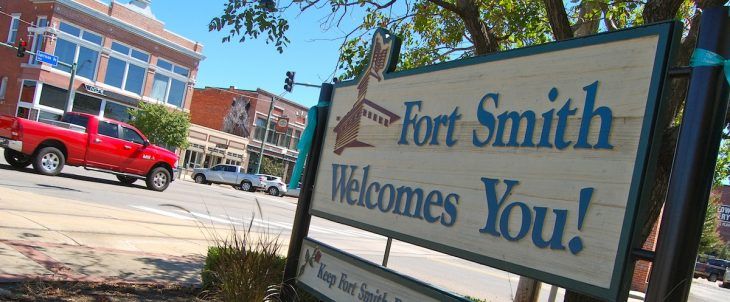Public input gathered on downtown Fort Smith truck issue
by February 26, 2019 6:47 pm 707 views

Downtown business and property owners and all others interested had the chance to learn a little more about a study looking at trucks and traffic in downtown Fort Smith on Tuesday (Feb. 26).
The Fort Smith Board of Directors passed a resolution in November that authorized an engineering services agreement with Halff Associates, Inc. of Little Rock for the Fort Smith Downtown Traffic and Truck Study. Consultants from Halff and ATG Alliance Transportation Group were available to all those interested in the study during a drop-in meeting at the River Park Events Building.
According to representatives present, the study involves several steps:
• Gathering information about downtown traffic;
• Determining exiting traffic patterns, including the level of truck traffic;
• Identifying existing constraints and suggested mobility improvements for downtown;
• Developing additional traffic improvement strategies;
• Evaluating potential impacts of strategies and solutions to those responsible for local movement of goods; and
• Creating a context-sensitive improvement plan that incorporates feedback from the community and stakeholders and achieves the goals of the study.
“We want to get an idea of how we can offer traffic improvements to promote safety, walkability and bikeability. We want to look at trucks and possible noise and air pollution. See if that might be an issue. We are really gathering information,” said Chris Stansbury, a transportation planner with ATG.
The study, not to cost more than $151,986, is based on recommendations from the Propelling Downtown Forward Plan, was adopted by the board in August 2017 as “a master plan addressing specific development and revitalization issues in the downtown and Central Business Improvement District (CBID) areas,” information on the study states.
Preliminary looks show congestion on Garrison Avenue is not bad, Stansbury said.
“At peak times, there is some congestion at Garrison and 11th during peak times. There are some hot spots,” he said. “Nothing really pops as a problem referring to congestion or crashes.”
The topic then turns toward livability downtown.
The subject of truck traffic downtown was brought up several times during panel discussions during the Invest Fort Smith Summit held Oct. 30 at Temple Live! in downtown Fort Smith. Mervin Jebaraj, an economist and director of the Center for Business and Economic Research at the University of Arkansas, who served on a closing panel discussion at the summit, said addressing the truck traffic and making the downtown more walkable is a key to bringing more retail and residential dwellings to the area.
“You really don’t want to see 18-wheelers on your downtown drag. … You don’t want to pause your conversation for five minutes while a truck passes,” he said.
The topic was also broached by Bill Hanna, a panelist in the opening discussion of the summit. Hanna, owner of downtown Fort Smith-based Hanna Oil & Gas, and a CBID member, said trucks are loud, are not pedestrian friendly, and make it difficult to create a walkable urban environment.
“If we want our downtown more livable, we’re going to have to figure out what to do with trucks,” Hanna said. “We have to figure out how to quiet downtown. That’s the challenge.”
Tuesday brought lots of interest from representatives of the trucking industry, Stansbury said.
“They are coming to the table. They understand trucks can be perceived as an issue. They want to be good members of the community and not unduly burden everyone else,” Stansbury said.
Representatives from Halff and ATG will meet with more stakeholders on Wednesday (Feb. 27) before continuing with their study. They also will send out questionnaires, and follow up with more questions, Stansbury said.
“The big factor is that with traffic coming in, there really isn’t another option than Garrison Avenue. It is the only entryway. It constructs a little bit of a tricky issue when it comes to proposing solutions,” he said. “You want to come up with something that allows that downtown vibe without burdening the truckers. It’s an interesting challenge.”
James Arbuckle, vice president with Halff and a project manager, said the goal is to have a report ready by the end of August. Alternative solutions will be presented to local representatives on the study’s committee, Arbuckle said.
“Representatives, both from the CBID and from trucking industry, are coming to the table open what solutions that could come out of this process,” he said. “It will definitely be a challenge to come up with something that can work. It’s going to take outside-of-the-box ideas. Right now we just have to gather as much information as possible.”
Private contributions to pay part of the cost of the study total $47,000 and are broken down as follows: Central Business Improvement District (CBID ), $20,000; OK Foods, $10,000; ArcBest, $5,000; Ghan & Robinson Family Foundation, $4,000; Arkansas Refrigerated Services, $3,000; First National Bank, $2,000; Phil White, $2,000; and Davis Iron & Metal, $1,000.
